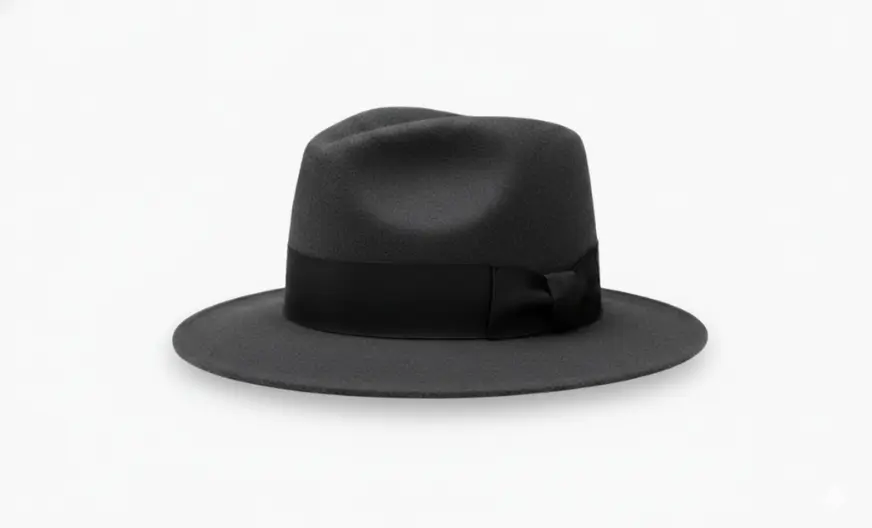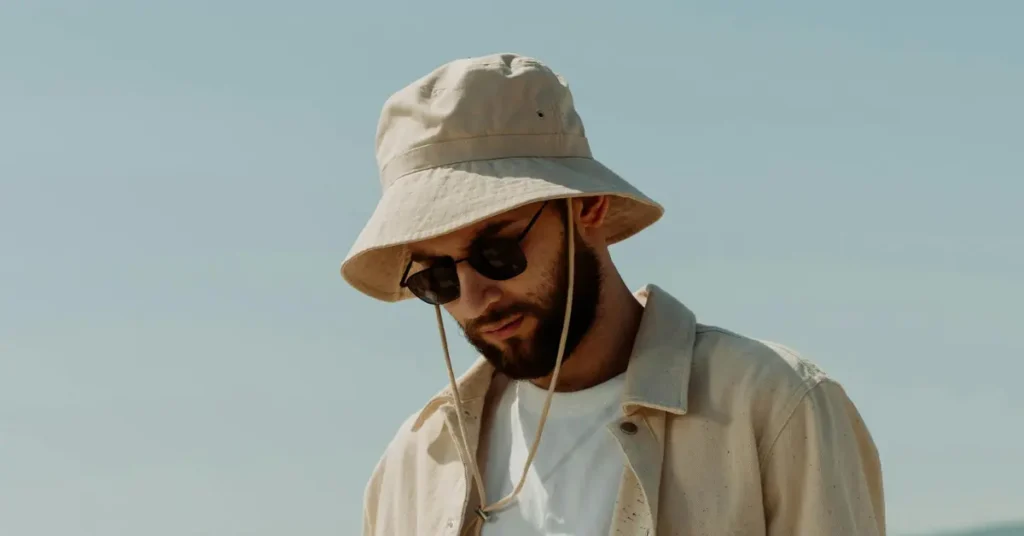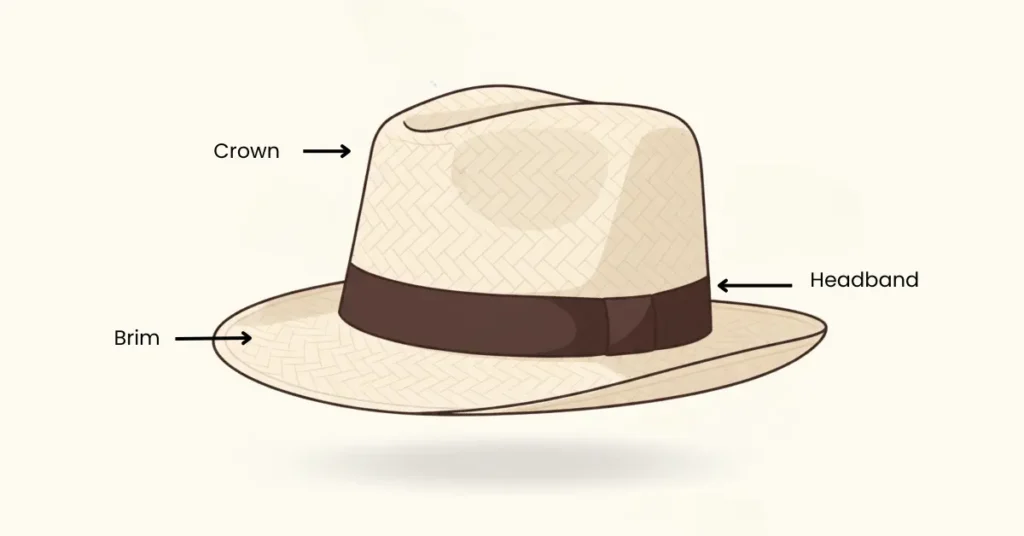Ever wondered what a fedora hat really is? A lot of people mix it up with trilbies or Panama hats, but it’s not the same.
A fedora has a soft brim, an indented crown, and a pinch at the front. You’ll find them in wool, straw, leather, or cotton, and the brim can be short, medium, or wide.
Both men and women wear fedoras for style, to stay shaded from the sun, or for formal occasions.
Fedoras have been around for more than a hundred years and got a big boost from people like Humphrey Bogart, Michael Jackson, and Indiana Jones. The hat goes well with many outfits and works for almost any occasion.
By the end of this guide, you’ll know everything you need to pick the right fedora and wear it confidently.
Parts of a Fedora Hat
Knowing the anatomy of a fedora helps you pick the right style and wear it with confidence. Take a look below to see each part.
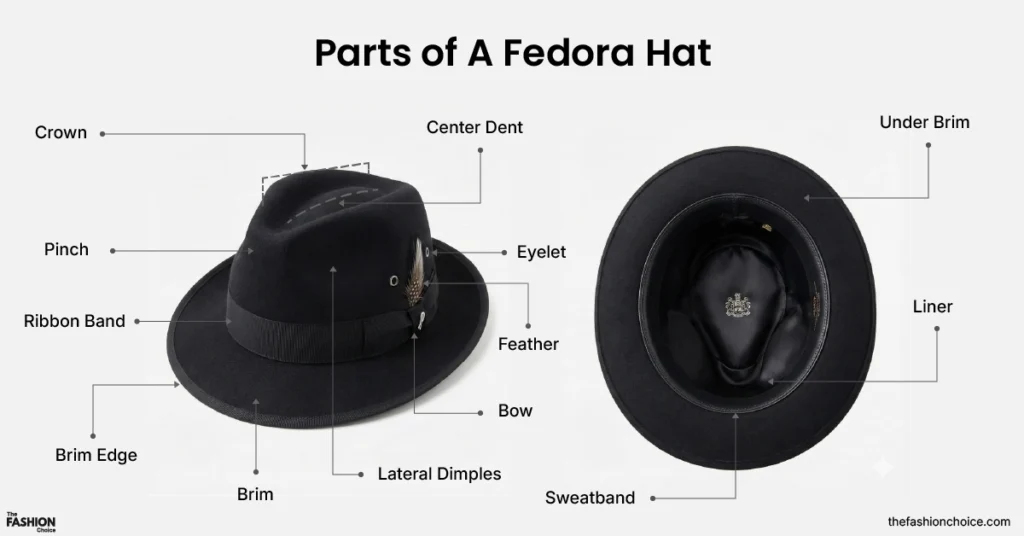
This infographic highlights all the key parts of a fedora hat for easy understanding.
Let’s break down the main parts, so you know what does what.
Crown
This is the top part that sits on your head. It gives the hat its shape. You’ll see different crown shapes like teardrop-shaped, diamond-shaped, or a center dent.
The shape changes how the hat looks on your head and how formal it feels.
Pinch
This is the little squeeze at the front of the crown. It sits right above your forehead. Some hats have a sharp pinch, some barely have one, but it’s one of the things that gives a fedora its classic look.
Center Dent
This is the crease running straight down the middle of the crown. It works with the pinch to keep the shape in place.
Lateral Dimples
These are the small dents on the sides of the crown. They don’t do anything special, but they help shape the fedora’s overall look.
Brim
This is the part that sticks out all around the hat. The size of the brim changes the style a lot. Short looks more casual. Medium or wide feels a bit more dressy.
Under Brim
This is just the bottom side of the brim. Sometimes it’s a different color or texture. It cuts down a bit of glare and adds a small style touch.
Brim Edge
This is the finish around the edge. It can be raw, stitched, or welted. A stitched edge holds up better. A Cavanagh edge looks the cleanest because the stitching is hidden.
Ribbon Band
This is the fabric band wrapped around the base of the crown. It gives the hat a neat, finished look. Mostly for style.
Bow on the Ribbon
On one side of the ribbon band, you’ll usually see a small fabric bow. It doesn’t do anything. It’s just there to finish the classic fedora look.
Sweatband
This is inside the hat. It helps the hat sit comfortably and keeps it from sliding around. It also absorbs sweat so the hat doesn’t get dirty too fast.
Liner
Some fedoras have a silk or satin liner inside the crown. It protects the hat from oils and adds a clean look inside.
Feather or Ornament
Some people like adding a small feather or decoration above the ribbon band. Purely optional. Just for style.
Eyelets
Some fedoras have small holes or mesh on the sides. These help with airflow and keep your head cooler, especially in warm weather.
If you struggle to understand the main parts of a hat, we’ve explained them clearly in another guide.
What Fedora Hats Are Made of
The material of a fedora hat really changes how it looks, feels, and when you should wear it. Each material has its own feel. Some look dressy, some look casual.
Here’s a simple breakdown so you can see which one fits your style and the weather.
Felt Fedoras
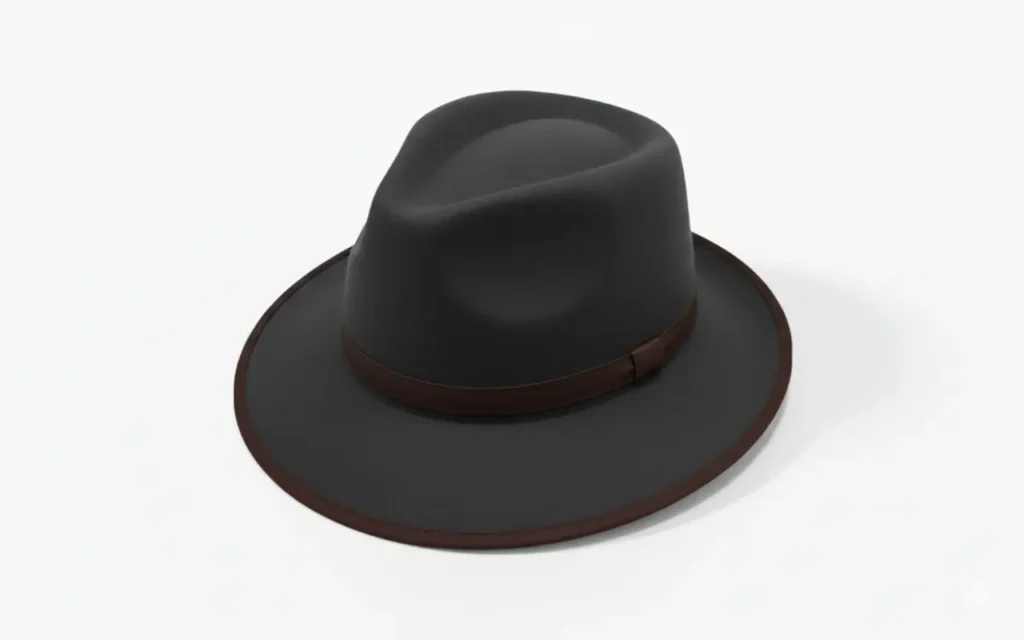
Felt is the most classic material for fedoras. It can be made from wool, rabbit, or beaver fur, and sometimes blends like mink or chinchilla are used.
Felt hats are durable, hold their shape well, and work great for both casual and formal wear. They are the most popular choice for men’s and women’s fedoras.
Straw Fedoras
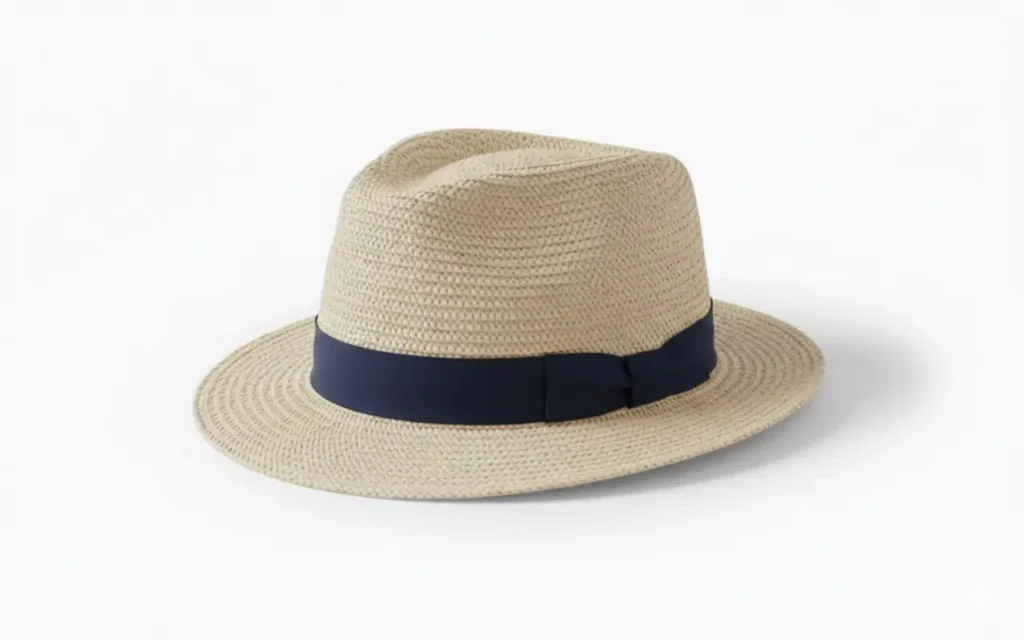
Straw fedoras are light, breathable, and perfect for summer. They’re often worn on sunny days or at outdoor events.
The weave and quality of the straw affect how stiff or soft the hat feels. Straw fedoras can be casual or dressy, depending on the brim and crown style.
Cotton Linen Fedoras
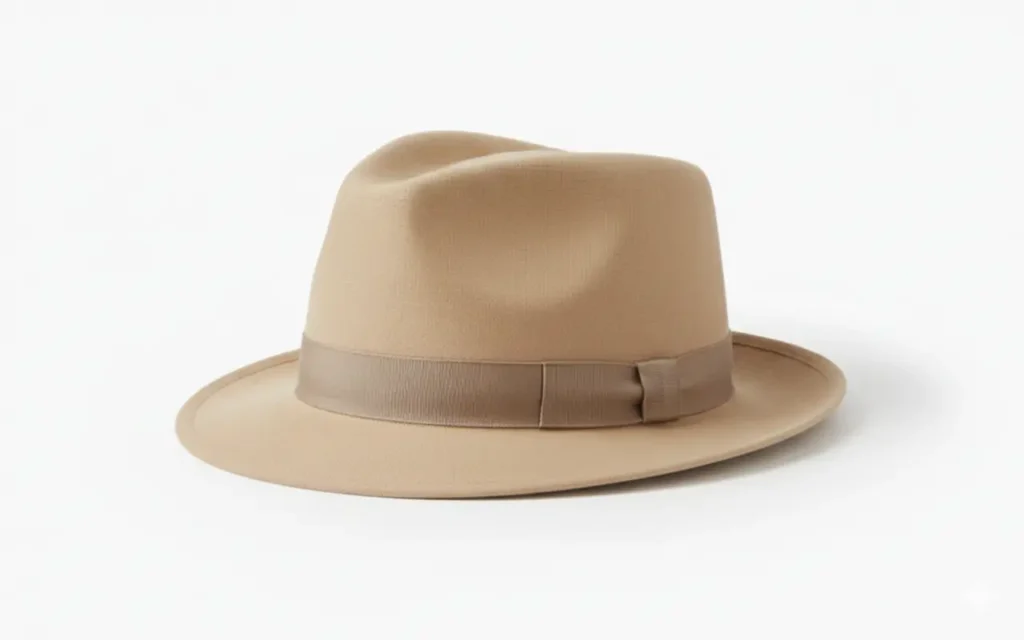
Cotton linen fedoras are soft and flexible. They’re great for casual outfits and warmer weather because they are breathable.
These fedoras often come in lighter colors and are easier to pack for travel since the can be folded or rolled without losing shape.
Leather Fedoras
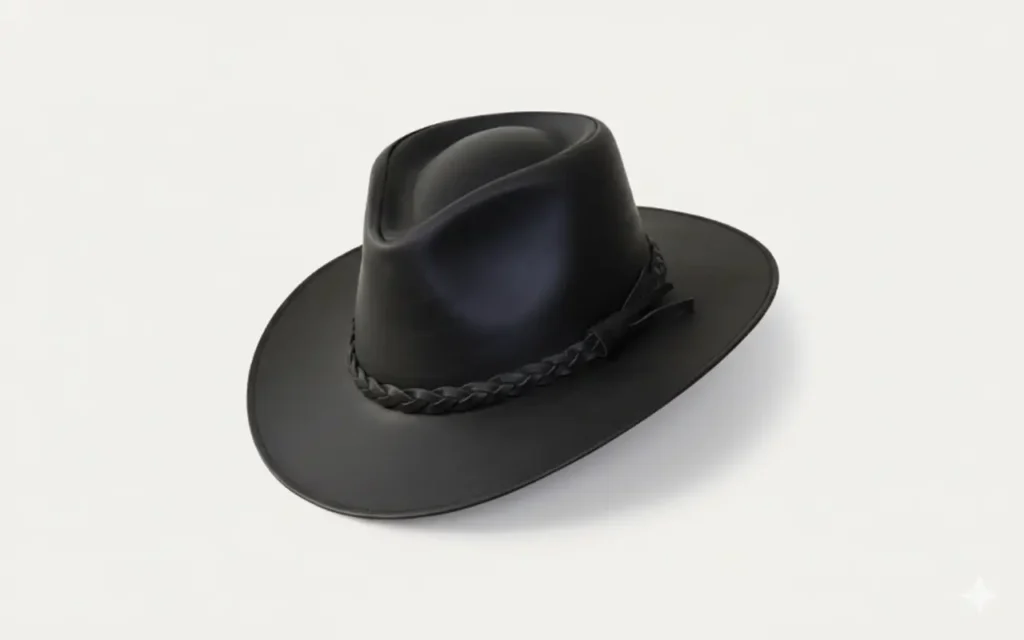
Leather fedoras have a unique look and feel. They are sturdy, weather-resistant, and give a bold, stylish vibe.
Leather fedoras are less common but are popular in fashion-forward outfits and for those who want a fedora that stands out.
Types of Fedora Hats
A fedora looks simple, but the differences usually come down to three things. What it’s made of, the shape of the crown, and how wide the brim is.
Once you understand these three, the whole Fedora world makes a lot more sense.
Fedoras Based on Crown Shape
The crown is the top part of the hat, and it largely defines the hat’s look and how it sits on your head.
Center Dent Crown
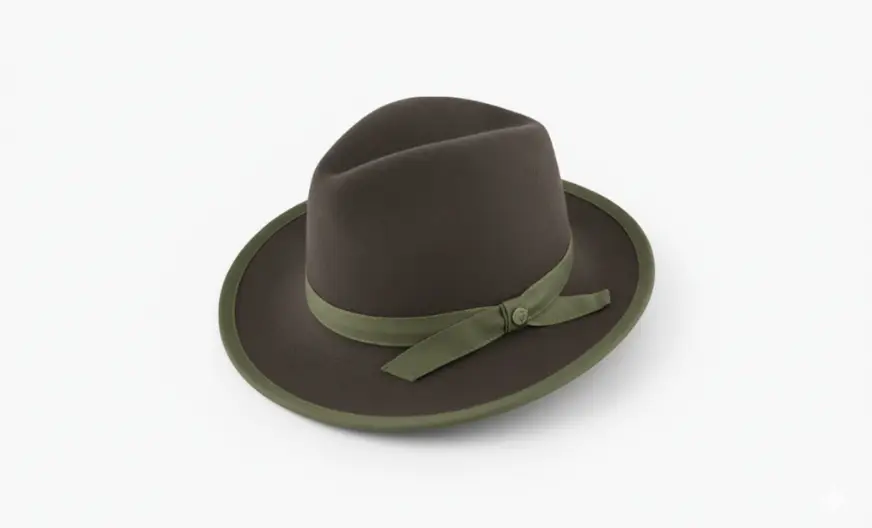
This is the most common crown shape. The crease runs straight down the middle, giving a clean, classic line.
Works for almost any face shape and is versatile for casual or formal wear. If you’re new to fedoras, start here.
Teardrop Crown
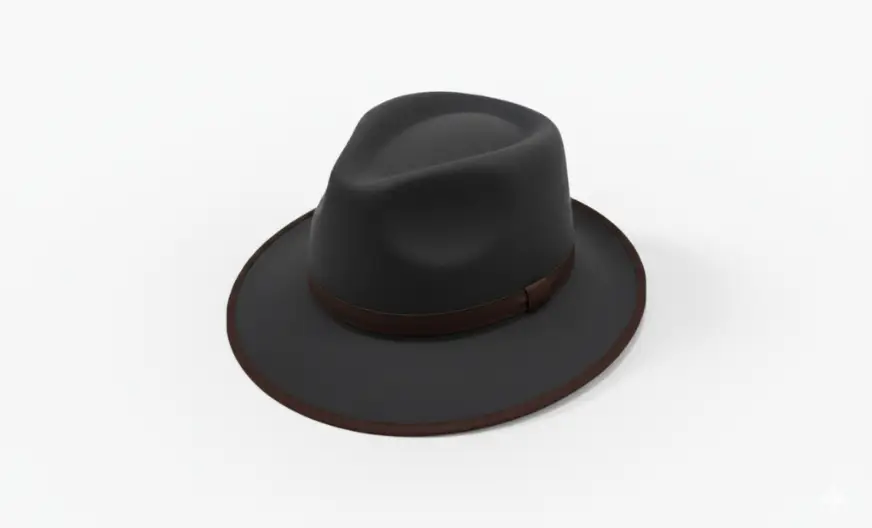
As the name suggests, this crown tapers like a teardrop. It’s modern, clean, and flattering for narrow or oval faces. It gives the hat a subtle, stylish edge without being flashy.
Diamond Crown
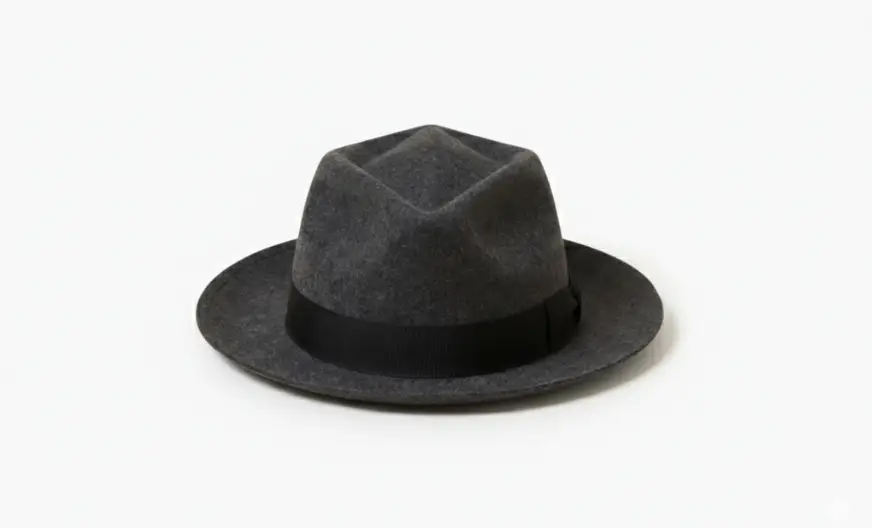
The diamond crown is less common. Its angles and pointed shape create a bold, fashion-forward look. Not everyone can pull it off, but if you wear one confidently, it definitely stands out.
Fedoras Based on Brim Size
The brim affects the style, sun coverage, and the overall vibe of the hat.
Wide Brim Fedora
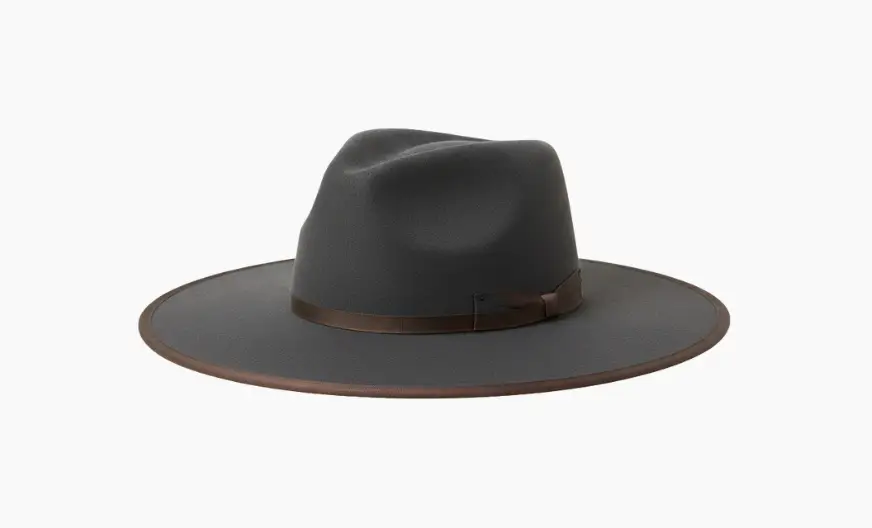
Usually 3-4 inches wide. It gives a bold, confident look and shades the face more. Good for outdoor events, photoshoots, or anyone who wants to make a statement.
Medium Brim Fedora
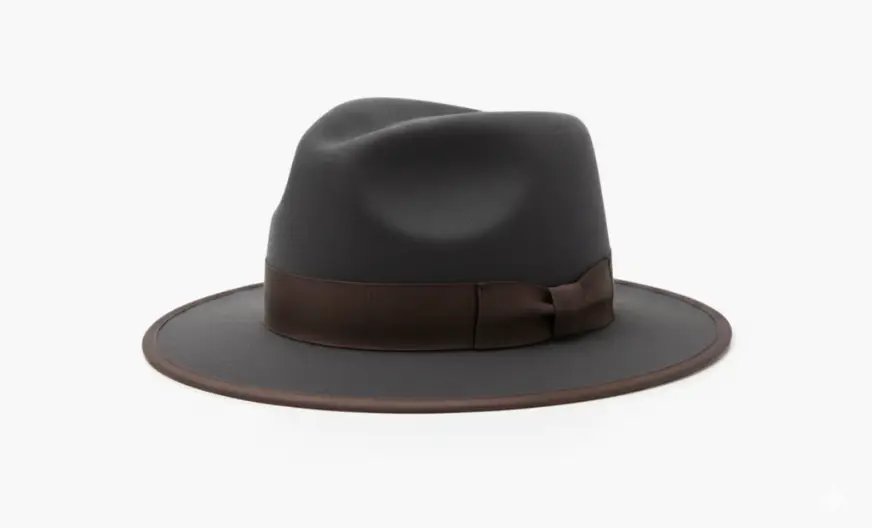
About 2.5-3 inches. Balanced and versatile. Works for daily wear, travel, casual outings, and semi-formal occasions. Most people find this size comfortable and natural.
Short Brim Fedora (Trilby Style)
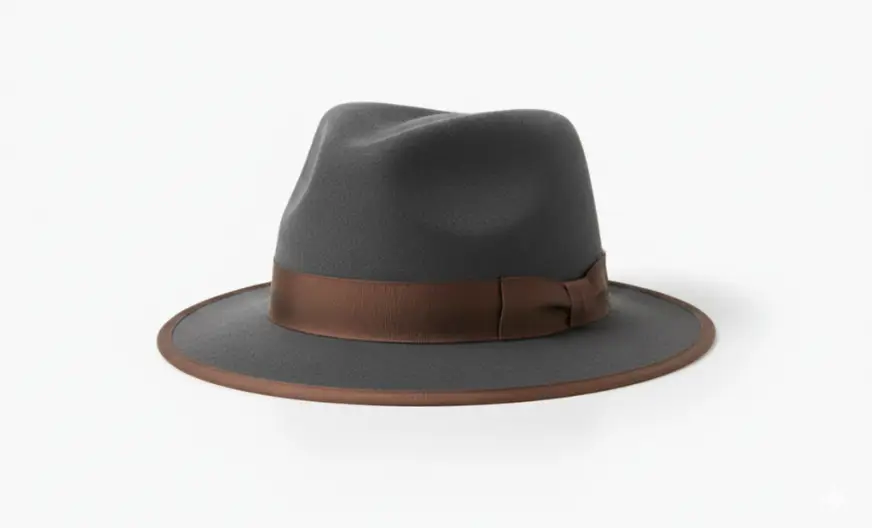
Around 2 inches. Gives a compact, casual feel. Common among younger people and for street-style looks. It blends easily with everyday outfits.
Snap Brim Fedora
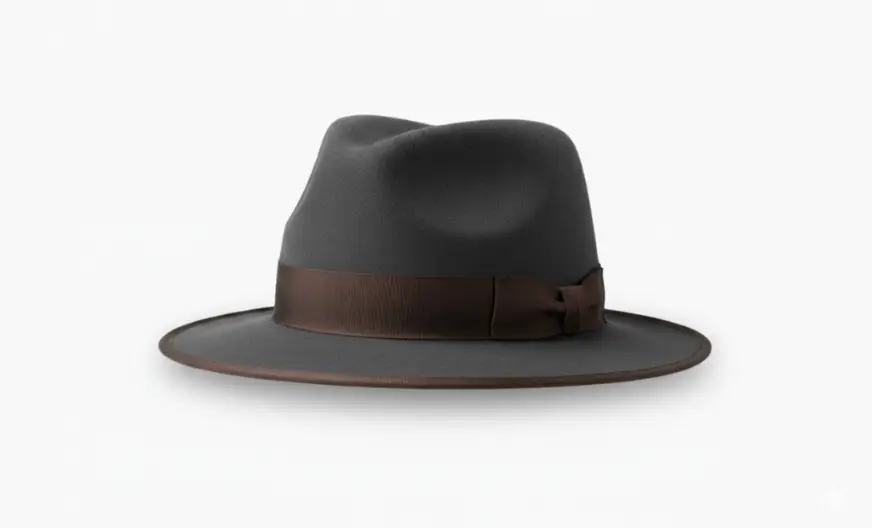
The brim can be snapped up or down. Snap it forward for a sharp, formal look; snap it up for a relaxed, casual vibe. This feature adds flexibility without changing the hat’s style.
If you want to explore other hat styles, check out our guide on types of hats.
How a Fedora Differs From Other Popular Hats
People get confused between fedoras, trilbies, and Panama hats because they can look similar at first. Let’s break it down in a way you’ll see clearly.
Fedora vs Trilby
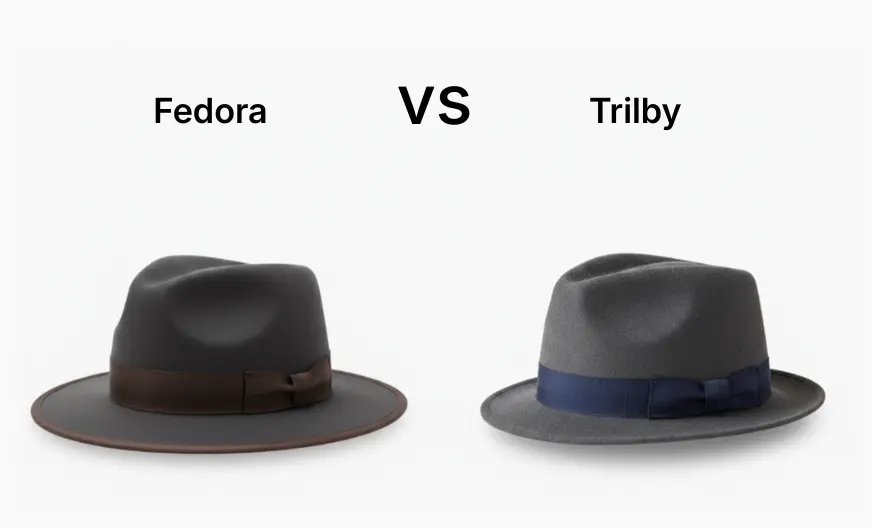
A fedora usually has a medium to wide brim, around 2.5 to 3 inches or more. Its crown is taller and keeps its shape well.
A trilby, in contrast, has a short brim, about 2 inches, often angled up at the back and down at the front. The crown is lower and a bit narrower.
In terms of style, a fedora works for formal, semi-formal, and smart casual outfits. A trilby is more casual and often seen in nightlife or street style looks.
How to identify:
Look at the brim first. Short and tilted up? Probably a trilby. Medium or wide with a structured crown? That’s a fedora.
Fedora vs Panama Hat

A lot of people confuse these because they both can have a soft brim. The big difference is the material.
Fedoras are usually made from felt (wool or fur), leather, or sometimes straw, and the crown is often structured.
Panama hats are handwoven from straw, so they’re light, breathable, and have a flatter crown with a wide brim.
If you want a hat that works for cooler weather or formal events, a fedora is the way to go. Panama hats are mainly for hot weather and casual wear.
History of the Fedora Hat
Fedoras have been around for over a hundred years. The origins of the fedora trace back to 1882, when it first appeared in a French stage play called Fédora, written by Victorien Sardou.
The lead, Princess Fédora Romanoff, was played by Sarah Bernhardt. She wore a soft hat with a crease in the center and a pinch at the front. This is considered the fedora’s first release, and people liked it so much that they started calling that style a “fedora.” Initially, it was mostly women who wore it.
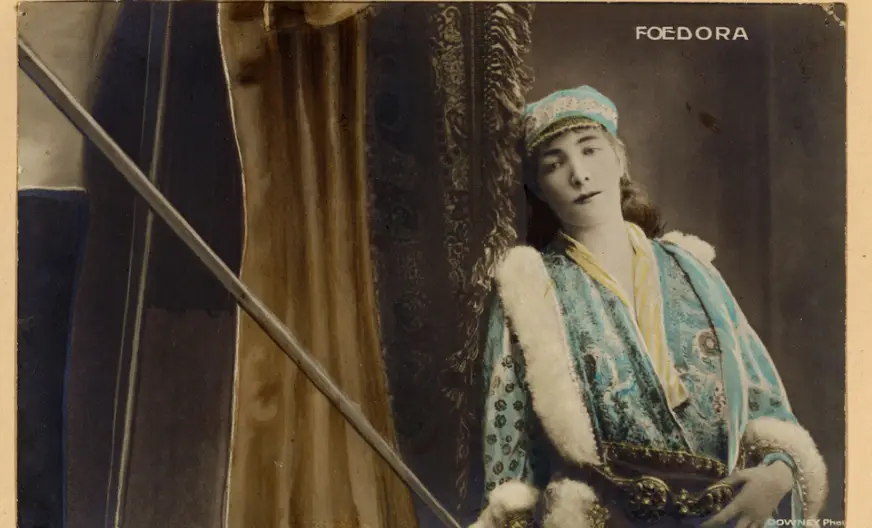
Sarah Bernhardt wearing the hat in the 1882 play Fédora, which inspired the name ‘fedora’. Image via Wikimedia Commons.
By the 1890s, women were wearing fedoras in daily life. It was much simpler and more practical than the big, fancy Victorian hats. For some women, it wasn’t just about style. It became a subtle symbol of independence during the early women’s rights movement.
Men picked it up soon after. The fedora became a common choice for everyday and formal wear. Businessmen, city workers, and even gangsters wore it with suits, overcoats, and dress shoes.

Al Capone wore fedoras regularly, and his photos from that time helped link the hat to the gangster look. Image via Wikimedia Commons.
The wide brim gave protection from the sun and rain, and the structured crown kept it looking sharp without being over the top. This was the “well-dressed man” look of the time.
In the 1940s and ’50s, Hollywood helped make the hat popular. Actors like Humphrey Bogart in Casablanca wore it and made it look mysterious and stylish.
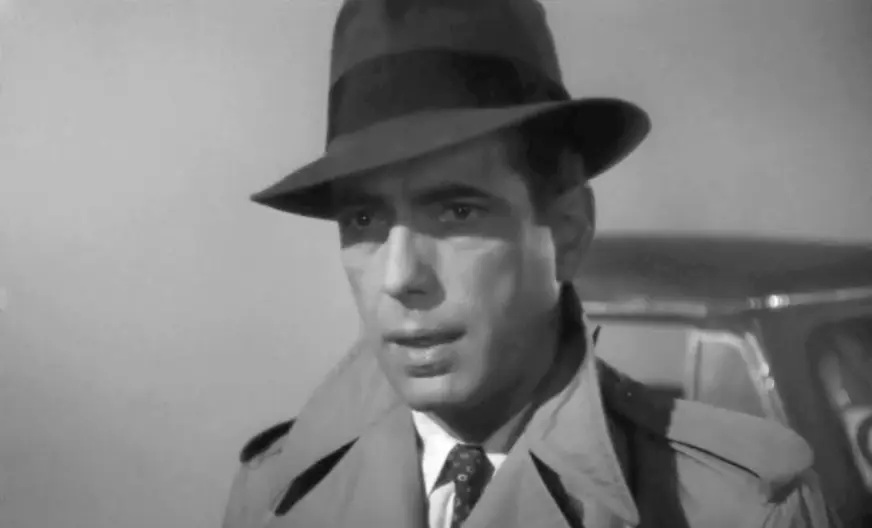
Humphrey Bogart wearing a classic fedora in Casablanca (1942), showing the iconic style of the era. Image via Wikimedia Commons.
Film noir movies added to their image. Gangsters on screen wearing fedoras gave it a bold, confident vibe. Fashion changed in the 1960s and 70s. People dressed more casually and stopped wearing structured hats every day. Baseball caps and beanies took over.
The fedora didn’t disappear completely. It kept appearing in movies and on stage. Indiana Jones wore a dark brown fedora in Raiders of the Lost Ark in 1981. Freddy Krueger wore a brown one in A Nightmare on Elm Street in 1984. Michael Jackson made his white fedora famous in Smooth Criminal in 1988.
By the early 2000s, fedoras started coming back as a vintage-inspired accessory. Today, people wear them at weddings, festivals, outdoor events, photoshoots, or even as part of street style. It’s not everywhere, but it still works as a stylish piece, especially in winter with coats, scarves, boots, or leather gloves.
If you’re curious about where hats started before the fedora even existed, we have a full guide that covers the early history of hats and how the whole thing began.
Who Wears a Fedora Today and When to Wear One
Men and women both wear fedoras. On the men’s side, you’ll see them on people who like classic, smart-casual looks, or those who work in creative industries where style matters.
Women wear them to add a stylish touch to everyday outfits or for formal occasions like weddings or garden parties. Celebrities, musicians, and influencers have helped fedoras stay relevant, but you don’t need to be famous to pull one off.
Certain communities also wear fedoras for tradition or religious reasons. Orthodox Jewish men, for example, often wear black fedoras as part of their daily or prayer attire.
As for when to wear one, keep it simple.
- A felt fedora works well with suits and coats, so it fits formal events or anything where you’re dressed.
- A short-brim or softer fedora works for casual days with jeans or a light jacket.
- In summer, a straw fedora is the better choice because it keeps your head cool and gives shade.
How to Choose the Right Fedora Hat
Choosing a fedora is easier when you know what you need it for. Here’s what to look at before buying one.
Understand Your Lifestyle Before Choosing a Fedora
First, look at your daily life and style.
If you spend a lot of time in an office, wear suits, or go to formal events, a classic felt fedora is the safest pick.
If you’re more into outdoor activities or casual streetwear, a soft-brim or straw fedora works better. The hat should fit naturally with your lifestyle.
Think About What You Want the Fedora to Do
Know why you want the hat.
Do you need it for style, sun protection, or warmth?
For summer, straw or ventilated fedoras are best. For winter, wool or felt fedoras keep you warm.
If you travel a lot, crushable or rollable fedoras are convenient. The purpose of the hat will guide your choice.
Check How the Fedora Fits Your Wardrobe
Look at your clothes and colors. If most of your outfits are dark, black, or brown, fedoras are safe.
For lighter clothes, straw or white fedoras look better. The hat’s color and material should blend naturally with what you usually wear.
Decide on the Material Based on Comfort and Occasion
Fedoras come in felt, wool, straw, cotton, linen, and leather. Each material feels and looks different.
- Felt and wool work well for formal or winter events.
- Straw and linen are light and breathable for summer or outdoor use.
- Leather fedoras give a casual or edgy look.
Choose based on comfort and the event.
Choose the Right Brim Size
The brim affects the style and feel. Medium brims (2.5-3 inches) are versatile for casual and formal wear.
Wide brims (3-4 inches) make a bold statement and give more sun protection. Short brims (around 2 inches) are perfect for casual or street-style outfits.
Check the Crown Shape
Crown shapes—teardrop, diamond, or center dent—define the hat’s character.
Teardrop and center dent crown are classic and formal. Diamond crowns look modern. Pick a crown that balances with your face shape and outfit.
Make Sure the Fedora Fits Comfortably
Fit is everything. The hat shouldn’t be tight or loose. A slightly snug fit is perfect. If it feels comfortable, you can wear it all day without any discomfort.
Match the Fedora to the Occasion
Finally, consider where you’ll wear it.
Weddings, dinners, or formal events call for a classic felt fedora. Casual outings work with soft or crushable fedoras.
Summer or outdoor events are ideal for straw or ventilated fedoras. Match the hat to both the occasion and the material, and it will always look natural.
Buying Checklist for a Fedora Hat
Buying a fedora is not hard, but you should know a few things before you spend your money. These are the tips we give people who ask us. They are simple, practical, and based on real experience.
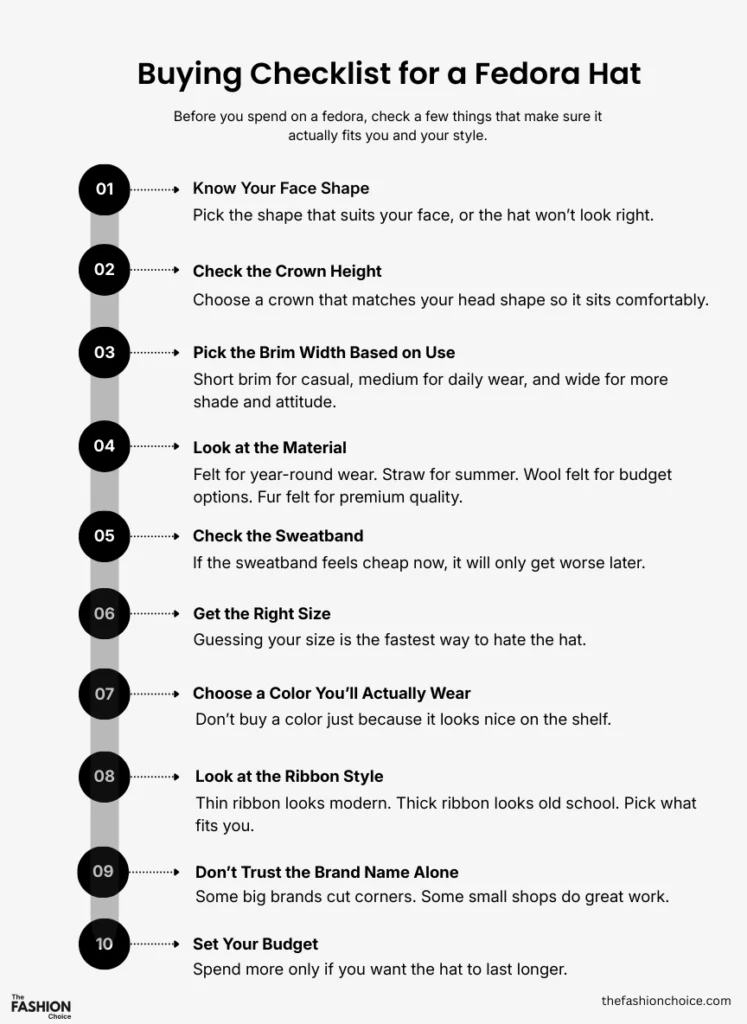
1. Know Your Face Shape
People skip this, then complain the hat does not suit them.
- A round face looks better with a higher crown and a medium brim.
- A long face looks better with a lower crown and a wider brim.
- A square face looks better with softer shapes and a slightly curved brim.
This one step already decides how natural the hat looks on you. If you don’t know your face shape, use our face shape calculator. It will tell you instantly.
2. Check the Crown Height
Crown height is not only about style. It also affects comfort.
If your head shape is long, a higher crown usually feels better. If your head is flatter, a lower crown often fits best.
Pick the crown that blends with your head shape.
3. Pick the Brim Width Based on Use
A short brim is good for casual wear. Medium brim looks classic and works for most outfits. A wide brim gives more sun protection and a bold look.
Pro Tip: Remember, wide brims do not suit everyone. If your shoulders are narrow, the hat might look too big.
4. Look at the Material
Wool fedoras are cheaper but do not hold their shape very long. Fur felt fedoras cost more, but they are stronger and stay in shape for years.
If you plan to wear the hat often, fur felt is the better choice.
5. Check the Sweatband
Cheap hats use plastic or stiff sweatbands that get uncomfortable fast. A good fedora has a leather or soft cotton sweatband. This keeps the hat steady and comfortable.
If the sweatband feels rough or cheap, skip that hat.
6. Get the Right Size
Do not guess your size. If the hat is loose, the wind will take it. If it is tight, it will give you a headache.
You want a snug fit. Not tight, not loose. If you don’t know your size, you can check it with our hat size calculator. It tells you your correct size in a few seconds.
7. Choose a Color That Complements Your Clothes
Black and brown are safe. Grey works with many outfits. The navy looks sharp, but does not match everything.
Pick a color you will actually use, not something that will sit in your closet.
8. Look at the Ribbon Style
A narrow ribbon gives a modern and simple look. A wide ribbon gives a more vintage look. This small detail changes the mood of the whole hat.
9. Do Not Trust the Brand Name Alone
Some small brands make great fedoras. What matters is the finish, stitching, material, and overall shape.
If the hat feels soft, floppy, or uneven, put it back.
10. Set Your Budget
You can find fedoras in every price range.
Wool is cheaper but does not last long. Fur felt costs more but stays in shape for years.
Spend a little more if you want the hat to last.
How to Wear and Style a Fedora Hat
We’ve seen a lot of people ruin a good fedora by just putting it on without thinking. A fedora isn’t just a hat—it’s part of your outfit.
Worn right, it can make even a simple shirt look sharp. Worn wrong, it can look awkward or try-hard.
Pair the Fedora with Clothes That Make Sense
Fedoras work best with structured clothing.
Men: a felt fedora looks good with a coat, blazer, or crisp shirt. Jeans and a T-shirt? Only if the fedora is casual, like straw or cotton.
Women: straw or soft fedoras go well with dresses or tailored pants. We usually tell people: the hat should add to your outfit, not fight with it.
Wear the Fedora at a Natural Angle
Don’t jam it too far back or tilt it too far forward. We often tip it slightly forward—it looks confident but relaxed.
Too much tilt or wearing it unevenly makes it look like you’re trying too hard. If you want to see a full guide on how to wear a hat properly, you’ll find a proper breakdown here.
Use Colors to Make It Work
Black and brown are safe bets. Gray works too.
Straw or beige is summer-friendly. Felt in darker shades works for winter outfits.
We usually tell people to pick a color that goes with most of their wardrobe, so it doesn’t feel out of place.
Keep Accessories Simple
Ribbons, small feathers, or bands can enhance a hat, but less is more. One simple detail is enough. Too much decoration can make it look overdone.
We’ve seen guys try bright feathers on a casual outfit.
It never works.
Stick to subtle details.
Think About Your Face and Height
Tall people can pull off wide-brim fedoras. Shorter people should go with narrow brims. Round faces usually do better with center-dent crowns.
We tell people: try a few styles in front of a mirror before buying—it makes all the difference.
Daily Wear vs Special Occasions
For everyday use, go simple. Neutral colors, medium brims, clean lines.
Bold styles, wide brims, or patterned fedoras are better for events or when you want to stand out.
How to Keep Your Fedora Clean Without Damaging It
A good fedora can last for decades if you take care of it properly. We’ve handled hundreds of fedoras over the years, and most damage comes from neglect rather than wear.
Here’s how we guide people to keep their fedoras looking sharp.
Handle Your Fedora Correctly to Preserve Its Shape
One of the biggest mistakes we see people make is grabbing the hat by the crown, especially the front pinch.
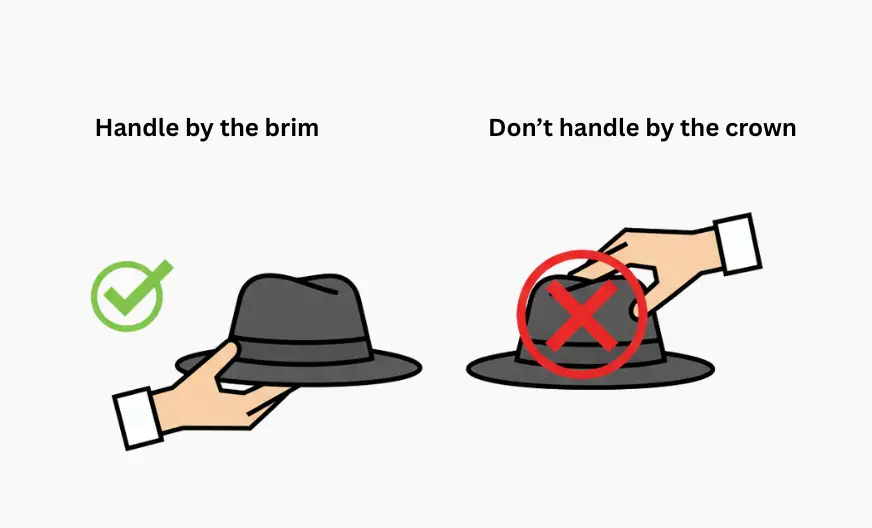
Doing this repeatedly can change the shape and flatten the crown over time. Always pick up and adjust your fedora by the brim.
It’s a small habit, but it keeps your hat looking structured and neat for years.
Store Your Fedora Safely When Not in Use
Storage makes a big difference. A cool, dry place is ideal, away from sunlight that can fade colors, especially on straw or lighter hats.
A hat box is perfect, but if you don’t have one, place the hat upside down on its crown or lay it on a clean shelf with the brim supported.
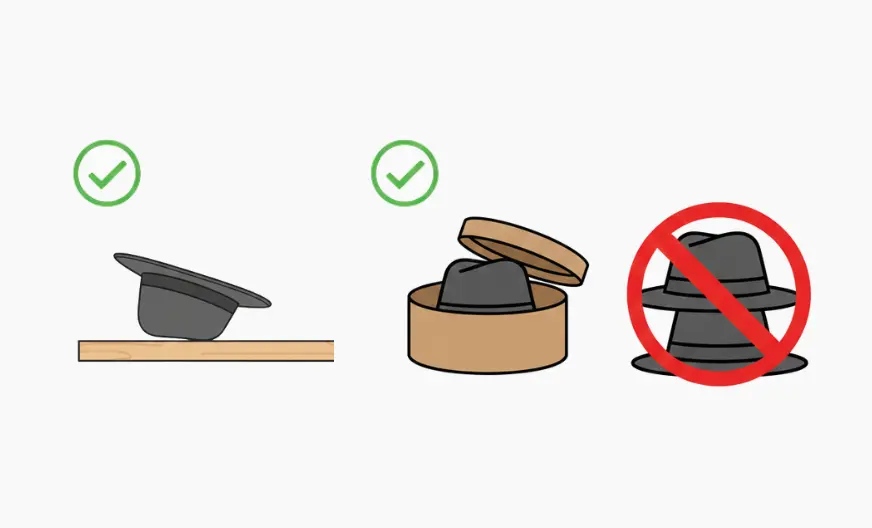
Never stack heavy items on top of a fedora—the crown or brim will deform fast.
Protect Your Fedora from Water and Moisture
Fedoras can take light rain, but avoid leaving them wet. Felt can shrink or lose shape, straw can warp, and leather may stiffen.
If your hat gets damp, let it air dry naturally on a flat surface. Don’t use hair dryers, heaters, or place it in direct sun, because heat damages the fibers and alters the shape.
Fix Minor Shape Issues at Home
Sometimes the brim or crown gets slightly out of shape. Gentle steaming works well for small adjustments.
Hold the hat above hot water for a few seconds and reshape carefully with your hands. Only use this for minor tweaks—anything serious is best handled by a professional hatter to avoid permanent damage.
Rotate Your Fedoras If You Wear Them Daily
If you wear fedoras regularly, don’t rely on just one. Rotating hats reduces wear and tear and prevents sweat and oils from breaking down the material.
It’s a simple trick that keeps every fedora in your collection looking fresh and sharp.
Your Thoughts on Fedoras
We’ve gone through everything about what a fedora hat is, how to choose the right hat, how to wear it, and how to care for it.
Which fedora style do you plan to try first, classic felt, straw, or leather?
Or maybe we missed one of your favorite styling or care tips for fedoras.
Share your thoughts in the comments below. We would love to hear how you plan to use a fedora hat in your style.
